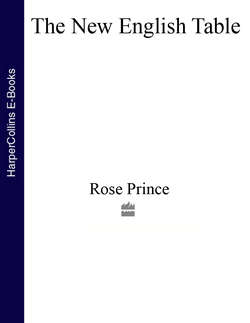Читать книгу The New English Table: 200 Recipes from the Queen of Thrifty, Inventive Cooking - Rose Prince - Страница 39
ОглавлениеBEANS
Bean Sprout and Herb Soup
Baked Beans with Bacon, Molasses and Tomato
Pinto Beans and Venison
White Bean Broth with Buttered Tomato and Lettuce
Bean and Herb Salads
Quick Braised Butterbeans
Rifling through the bags of beans in the kitchen drawer, it’s easy to imagine how a geologist feels about his collection of favourite pebbles. Beans make funky percussion noises as they fall around in the bags, a hollow sound reminding us that here is a dry store, a useful source of food. And they are so pretty. Spotty like bird’s eggs, black, purple, white, red and green – it’s a glamorous palette for a humble, economic food. But what a food. My week never passes without a foray into the drawer for one type or another and, depending on whether I use dried beans or canned cooked ones, a pan will soon be simmering with something good under the lid. White beans, garlic and tomatoes are a classic combination; meaty-flavoured brown beans taste good with a hint of sweet-sourness and the richness of added pork; Mexican black beans are a favourite, because they are not too floury; green flageolet beans with shallots and butter is a dish I will keep going back to all my life. More recently, I have discovered that mung bean sprouts are lovely in herby soups.
However, with names like flageolet, haricot and cannellini, we are not talking of one British pulse. All beans sold dried or cooked and canned are imported. But they belong in our kitchens on various counts. One is that we do not grow them – we could, and should, develop some varieties, however – and the other is that we, the British, not famous for eating any beans other than Heinz, would discover that they make a valuable addition to our diet. Beans, along with lentils, grains and peas, need to become a central quotidian food. This is why:
Buying into beans is a humanitarian deed. They are the ultimate low-impact food, being as good for the places where they grow as they are for human nourishment. Their virtues are remarkable: they need little water compared to other food crops, tending to grow well in dry climates (major producers are Africa, India, Pakistan, Turkey and the Middle East); there are hundreds of varieties, so they are a diverse, anti-monoculture food crop whose cultivation benefits soil fertility and increases protection against disease and pests; bean plants also fix nitrogen in the soil, and so are intrinsic to traditional crop rotation as a ‘green manure’ – they also grow well without chemicals in an organic system and tend to be grown with the assistance of pesticides only when the farmer can afford it. A pulse grown in a developing country is usually free of spray. When last tested by the UK’s pesticides residue committee, only 11 out of 81 samples tested positive for residues. These results are quite favourable for the consumer, but it is easy to buy pulses from an organically certified source.
On the downside, beans are still largely a commodity crop and there are very few fairly traded beans on the British market, although Suma, an organic supplier, sells fairly traded aduki and black beans.
On a more selfish note, we should eat more beans because they are so good for us. They are a low-cost way of eating a high-protein food containing plenty of healthy complex carbohydrates. They are packed with vitamins, iron and calcium. It is important to note, however, that while fresh beans are very high in vitamin C, dried beans contain virtually none. The good news is that canned beans, which tend to be cooked using fresh pulses, retain about 50 per cent of their vitamin C. I was delighted to discover this, as I have always felt guilty about buying canned beans, believing I should virtuously go through the whole cooking process. The truth is I rarely have the time, although it must be said that there is a much wider range of dried beans available, including some rare ones like appaloosa beans from America and black turtle beans from China.
Buying beans
I buy from Infinity Foods, a workers’ co-operative in Brighton that sells a vast range of high-quality pulses. (See www.infinityfoods.co.uk; tel: 01273 424060). Monika Linton imports great beans for her London-based business, Brindisa, both dried and bottled, rather than canned (www.brindisa.com; tel: 020 8772 1600).
Basics when preparing dried beans
Unlike lentils, beans need to be soaked before cooking or they will split. If you soak them in cold water for several hours or overnight, then boil them for the correct amount of time, they should stay intact and slip lightly around the pan, mixing well with the other ingredients. It would be good to have a chart of cooking times for beans but no such thing can exist. The cooking time depends on size and type and also, more crucially, on how recently the beans were picked and dried – the older a bean is, the longer it takes to cook. It must be said that most beans sold in the UK are fairly aged, so expect to leave them for a good 1½–2 hour simmer. Test after about 50 minutes, though, just in case they are done. Overdone beans are floury and disgusting.
